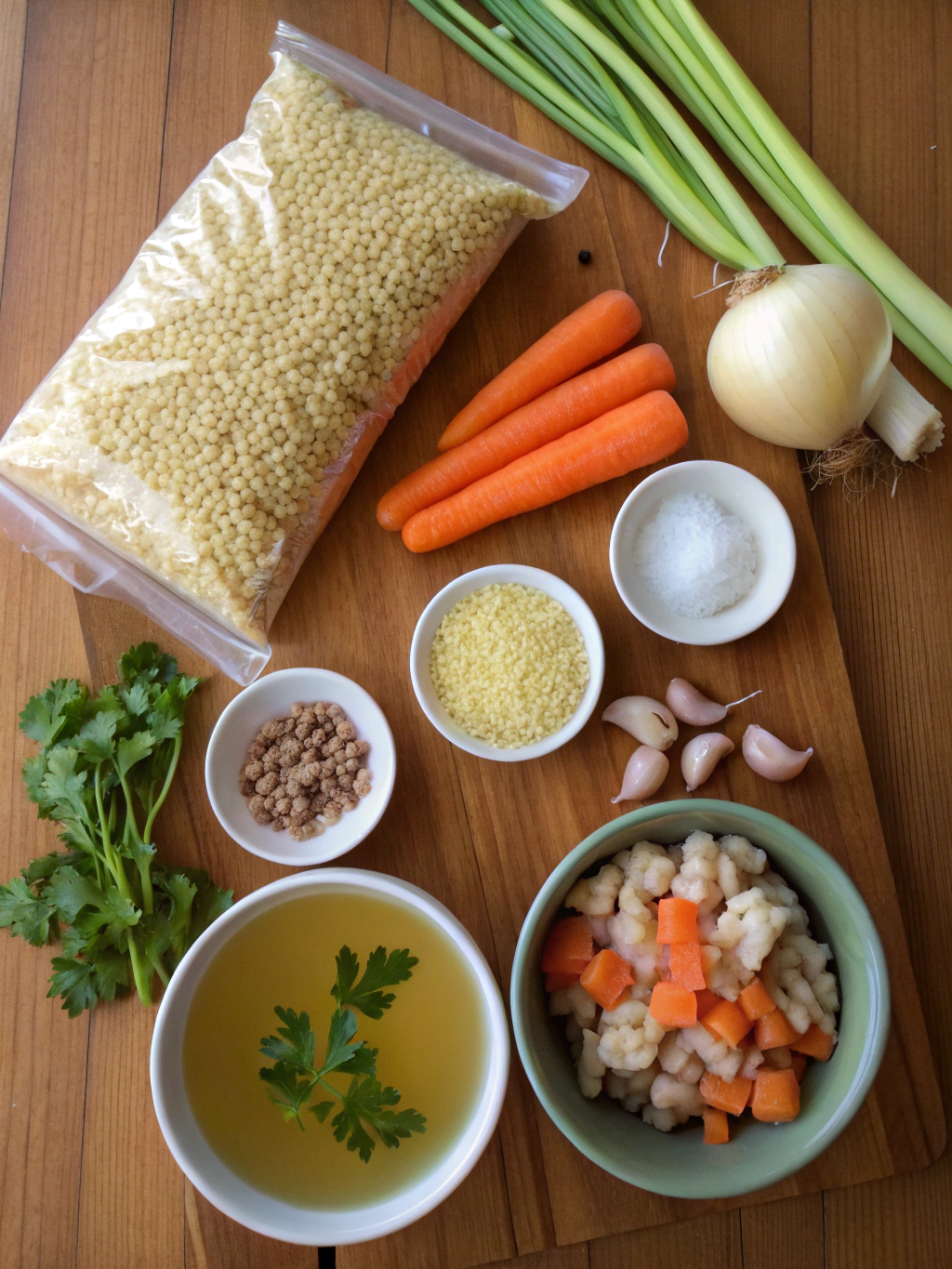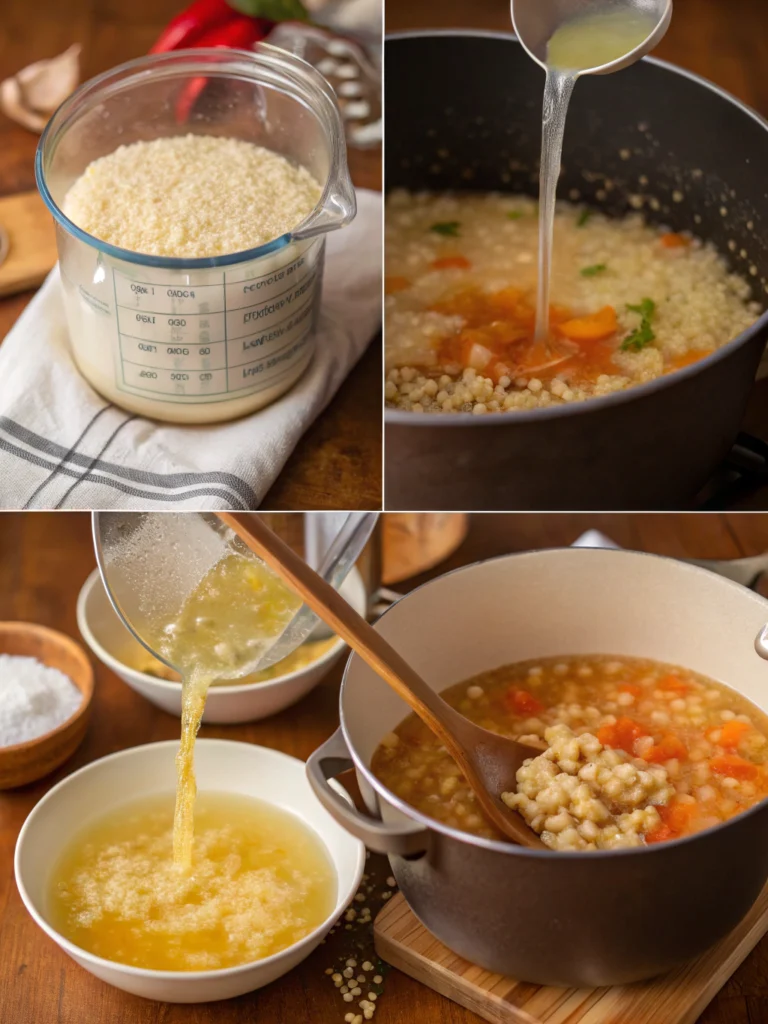Have you ever wondered why a simple bowl of pastina soup can transport you back to childhood comfort faster than any other food? This humble Italian staple has been soothing souls and healing colds for generations, yet so many people struggle to recreate that perfect, silky texture and balanced flavor at home.
Today, I’m sharing my grandmother’s Pastina Soup recipe, which has been perfected over the decades. This soul-warming dish combines tiny star-shaped pasta with rich broth and simple ingredients for a meal that’s both nourishing and nostalgic. Whether you’re feeling under the weather or simply craving comfort, this recipe delivers warmth in every spoonful.
Ingredients List

The beauty of a great Pastina Soup Recipe lies in its simplicity. Each ingredient plays a crucial role in achieving the perfect balance of flavor and comfort. Here’s everything you’ll need:
- 1 cup pastina (tiny star-shaped pasta) – can substitute orzo or any small pasta shape
- 8 cups homemade or low-sodium chicken broth – vegetable broth works for a vegetarian option
- 2 tablespoons extra virgin olive oil
- 1 medium onion, finely diced
- 2 medium carrots, finely diced
- 2 celery stalks, finely diced
- 3 cloves garlic, minced
- 1 bay leaf
- 1/2 teaspoon dried thyme
- 2 tablespoons fresh parsley, chopped
- 1 tablespoon fresh lemon juice
- 1/4 cup grated Parmigiano-Reggiano cheese, plus more for serving
- Salt and freshly ground black pepper to taste
- Optional: 1 beaten egg for “egg drop” style soup
Timing
- Preparation Time: 15 minutes for chopping and measuring ingredients
- Cooking Time: 30 minutes, which is significantly faster than traditional Italian soups that often simmer for hours
- Total Time: 45 minutes from start to finish – perfect for weeknight dinners when you need comfort food without the wait
- This easy pastina soup recipe comes together much quicker than most homemade soups, making it ideal for busy evenings or when you’re feeling under the weather and need something nourishing without spending hours in the kitchen.
Step-by-Step Instructions

Follow these simple steps to create the perfect pastina soup that rivals any Italian grandmother’s recipe. Each step builds flavor, ensuring your soup has that authentic, homemade taste.
Step 1: Prepare Your Aromatics
Heat the olive oil in a large pot over medium heat. Add the diced onions, carrots, and celery (the Italian “soffritto”), and sauté for 5-7 minutes until the vegetables soften and the onions become translucent. Add the minced garlic and cook for another 30 seconds until fragrant, being careful not to burn it.
Step 2: Create Your Broth Base
Pour in the chicken broth and add the bay leaf and dried thyme. Bring the mixture to a gentle boil, then reduce the heat to maintain a simmer. Season with a pinch of salt and pepper (go easy on the salt if using store-bought broth). Let the broth simmer for about 10 minutes to allow the flavors to meld together.
Step 3: Cook the Pastina
Add the pastina to the simmering broth and cook according to package directions, usually about 5-7 minutes. Stir occasionally to prevent the tiny pasta from sticking to the bottom of the pot. The pastina will absorb some of the broth as it cooks, creating that signature creamy texture that makes this soup so comforting.
Step 4: Enrich the Soup
If using the egg drop method (a traditional addition that adds protein and silkiness), reduce the heat to low. Slowly drizzle the beaten egg into the soup while stirring gently with a fork to create delicate strands. Stir in the fresh lemon juice and grated Parmigiano-Reggiano cheese until well incorporated. The cheese will melt into the broth, creating a velvety texture.
Step 5: Finish and Serve
Remove the bay leaf and discard it. Stir in the chopped fresh parsley. Taste and adjust seasoning with additional salt and pepper if needed. Ladle the hot soup into bowls and garnish with extra grated cheese and a sprinkle of fresh parsley. Serve immediately with crusty Italian bread for the complete experience.
Nutritional Information
Understanding the nutritional profile of your Pastina Soup Recipe helps you make informed dietary choices. Based on an average serving size of approximately 1.5 cups:
Calories: 220 per serving
Protein: 9g (18% of daily recommended intake)
Carbohydrates: 28g (9% of daily recommended intake)
Fat: 8g (12% of daily recommended intake)
Fiber: 2g (8% of daily recommended intake)
Sodium: 650mg (28% of daily recommended intake, lower if using homemade broth)
Calcium: 120mg (12% of daily recommended intake)
This soup provides a good balance of macronutrients while delivering essential vitamins A and C from the vegetables, along with minerals from the broth. The pastina offers easily digestible carbohydrates, making this an ideal food when recovering from illness.
Healthier Alternatives for the Recipe
You can easily adapt this Pastina Soup Recipe to suit various dietary needs without sacrificing flavor:
For lower carbohydrates, reduce the pasta to 1/2 cup and increase the vegetables. You can also substitute protein-rich quinoa for added nutritional benefits.
Make it dairy-free by omitting the Parmigiano-Reggiano and adding a tablespoon of nutritional yeast for a similar umami flavor. Finish with a drizzle of good olive oil for richness.
For a protein boost, add 1 cup of shredded rotisserie chicken or 1 can of drained and rinsed cannellini beans during the last 5 minutes of cooking.
Use whole-grain pastina if available, which offers more fiber and nutrients than traditional white pasta varieties. The cooking time may increase slightly, so check the package instructions.
Serving Suggestions
Elevate your pastina soup experience with these serving ideas that complement its delicate flavors:
Serve in warmed bowls with a side of garlic-rubbed crostini for dipping. The contrast between the soft soup and crunchy bread creates a delightful textural experience.
For a complete meal, pair with a simple arugula salad dressed with lemon, olive oil, and shaved Parmesan. The peppery greens balance the soup’s comforting qualities.
Create a topping bar with extra-grated cheese, red pepper flakes, fresh herbs, and lemon wedges, allowing each person to customize their bowl according to taste preferences.
For special occasions, serve in small cups as an appetizer before a larger Italian meal. This traditional approach honors the soup’s heritage as a “primo piatto” or first course.
Common Mistakes to Avoid
Even simple recipes have pitfalls. Here are the most common mistakes when making pastina soup and how to avoid them:
- Overcooking the pastina: These tiny pasta shapes cook very quickly and continue absorbing liquid as they sit. Cook until just al dente to prevent mushiness.
- Using only water instead of broth: The broth provides essential flavor. If you must use water, increase seasonings and add a bouillon cube.
- Adding cold eggs directly: This can result in scrambled eggs rather than silky strands. Always temper the egg by whisking in a small amount of hot broth first.
- Skipping the sautéing step: Taking time to properly sauté the vegetables develops foundational flavor that makes the difference between mediocre and magnificent soup.
- Under-seasoning: Taste as you go! Proper seasoning throughout the cooking process builds layers of flavor that can’t be achieved by only adding salt at the end.
Storing Tips for the Recipe
Pastina soup can be prepared ahead and stored properly to enjoy throughout the week:
Refrigeration: Store cooled soup in airtight containers for up to 3 days. The pastina will continue absorbing liquid, so when reheating, add a splash of broth or water to restore the original consistency.
Freezing: For best results, freeze the broth base without the pastina. When ready to serve, thaw the broth, bring to a simmer, and cook fresh pastina directly in the broth.
Make-ahead strategy: Prepare the vegetable and broth base up to 2 days ahead, refrigerate, then simply heat and add pastina just before serving for the freshest texture.
For meal prep, store individual portions in microwave-safe containers for quick lunches or dinners throughout the week. A squeeze of fresh lemon just before eating will brighten flavors that may have mellowed during storage.
Conclusion
This traditional pastina soup represents the heart of Italian comfort cooking – simple ingredients transformed through care and attention into something truly nourishing. The beauty lies in its adaptability; make it richer with egg and cheese when seeking comfort, or lighter with extra vegetables when focusing on health.
I’d love to hear how your pastina soup turns out! Did you try any variations or have a family twist on this classic recipe? Share your experience in the comments below or tag us in your soup photos on social media. And if you enjoyed this recipe, be sure to check out our other Italian comfort food classics. Buon appetito!
